Necchi sewing machines rivaled all other sewing companies worldwide during the mid-20th century. The original Necchi models shocked the world with new technology and impeccable manufacturing. Necchi sewing machine models, history, and value tell an interesting story!
Vittorio Necchi launched Italy’s first sewing machine manufacturing company in 1924. With a reputation for excellence, Necchi models were sold like hotcakes around the world. Today, vintage Necchi sewing machines come with a high price and high quality.
In this article, you’ll find out where Necchi sewing machines came from. You’ll discover fun facts about the most popular vintage models. Finally, you’ll learn how to date and price your vintage Necchi sewing machine!
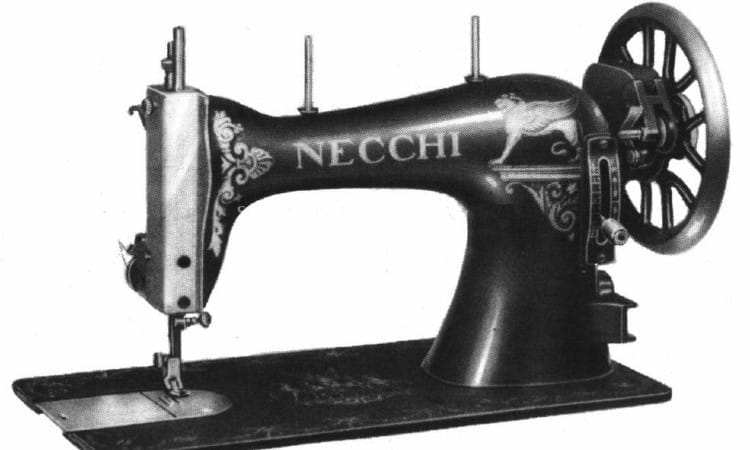
History of Necchi Sewing Machines
Vittorio Necchi founded his family-run sewing machine company after the end of WWI. Unlike many other sewing machine inventors spurred on by the industrial revolution at the end of the 1800s, Necchi famously decided to make an improved sewing machine after his wife sent him out to buy one for her!
Though this anecdotally took place in 1919, Necchi opened his factory and began producing machines to sell in 1924. Necchi’s family had previously owned a small iron foundry, so he grew the sewing machine out of those roots. At first, the company had a small group of just 40 employees and sold around 2,000 machines a year.
By 1930, the company had produced more than 20,000 machines. On top of that, the Necchi reputation flourished so dramatically that the company exported sewing machines to sell in 30 different countries!
Vittorio kept a hands-on approach to the entire process of sewing machine manufacturing. His company developed four different divisions over time. These included the foundry for the metal parts, heavy-duty industrial sewing machine construction, cabinetmaking to create the tables and cabinets that housed the domestic machines, and domestic sewing machine manufacturing.
Necchi literally built every bit of the machines from the ground up! This allowed the company to ensure the highest possible quality in its machines.
As the first sewing machine manufacturer in Italy, Necchi received a lot of attention from the beginning. As time went on, the company also won several prestigious awards for the innovative designs used in its sewing machines. These included the Compasso D’Oro award and the Grand Prix award at the Triennale di Milano.
Vittorio, affectionately known as “the old man,” remained involved in his company for many decades. However, he also leaned on several key figures for support and new ideas as time went on. For example, Leon Jolson spearheaded export to the US in the 1950s.
Jolson had survived the Holocaust during WWII and immigrated to New York City in 1947. He saw room for advanced sewing machine models in the old-fashioned sewing industry in New York at the time. Based on this, he visited Italy and persuaded Vittorio Necchi to open a sales campaign in the States.
Vittorio knew a good business opportunity when he saw one, and Jolson became the dealer spearheading the export of 10,000 models to the United States within just two weeks!
The 1950s saw a huge expansion of the Necchi company, outrageous sales, and several truly brilliant sewing machine innovations.
Sadly, the 60s saw this golden era come to an end. Like many other sewing machine companies, Necchi struggled to keep up with competition from Japans’ post-war sewing machine boom. On top of this, the company briefly tried to cut costs by having some Necchi models manufacturing in Japan during the 70s and 80s.
Vittorio’s death in 1975 heralded the end of the family-run company. Several other companies bought and sold the Necchi brand name during the following decades. Toyota briefly made Necchi sewing machines.
In the 2000s, Janome bought the brand. Janome continues to sell “Necchi” sewing machines today. These models look quite similar to Janome models and just have a different brand name.
Do They Still Make Necchi Sewing Machines?
You can still find brand-new Necchi sewing machines on the market today. Though Necchi has its own website, Janome bought the brand name. Janome actually designs, builds, and sells all modern Necchi models.
That said, these modern Necchi machines do not bear much resemblance to the Italian-made vintage models produced at Vittorio Necchi’s factory.
Janome makes good modern sewing machines. They come with all the computerized bells and whistles you would expect. Plus, Janome has a good reputation for customer service.
But new sewing machines use cheap plastic parts instead of the solid metal construction used in the first half of the 20th century. You should not expect high-quality craftsmanship from a modern Necchi like you could from a vintage model!
Where Are Necchi Sewing Machines Made?
Today, Janome farms out Necchi sewing machine manufacturing to several factories in Southeast Asia. Vintage Necchi sewing machines made between 1924 and the mid-1960s were made in Necchi’s Italian factory. For a brief period, some Necchi models made during the 1970s and 1980s were made at a factory in Japan.
This doesn’t mean that Janome and Janome-made Necchi models are bad sewing machines! Janome has a pretty great reputation in the sewing world. But just don’t expect the brilliant design and craftsmanship that won awards for Necchi during its golden age.
Modern Necchi models have good if unexceptional design components, but their overseas manufacturing and plastic parts make them less durable and dependable than older models.
Vintage Necchi Sewing Machine Models
Vintage Necchi sewing machines got a lot of buzz back in the day, but they remain quite famous today, too!
This chart gives you the highlights of the most famous Necchi models and their production years. For more in-depth information about the most popular models of all time, keep reading!
As a quick note of explanation about the model names, the designation BF stood for straight-stitch models. BU indicated zigzag models. For this reason, you can see a BU and BU Mira and BU SUpernova, and the list goes on!
Plus, Necchi did not release model names in any discernable order. Even the 500 model numbers jump all over the place in terms of production years. You just kind of have to go with the flow on these model names!
| Necchi Model | Year Made |
| BD | First model, 1924 |
| BC | Early model–unknown date |
| BU | 1932-53 |
| BF Mira | 1950 |
| BU Mira | 1952-56 |
| BU Nova | 1953 |
| Supernova | 1954 |
| BU Supernova | 1955-58 |
| Mirella | 1956, various models in production till 1973 |
| 524 “Lydia” | 1955 |
| 514 | 1957-61 |
| Esperia | 1958-63 |
| Supernova Ultra | 1958-63 |
| 510 | 1961 |
| 534 Supernova Julia | 1961-71 |
| 513 | 1961 |
| 512 | 1962-71 |
| Sylvia Multimatic | 1963-78 |
| 592 Logica | 1983-89 |
Necchi BU
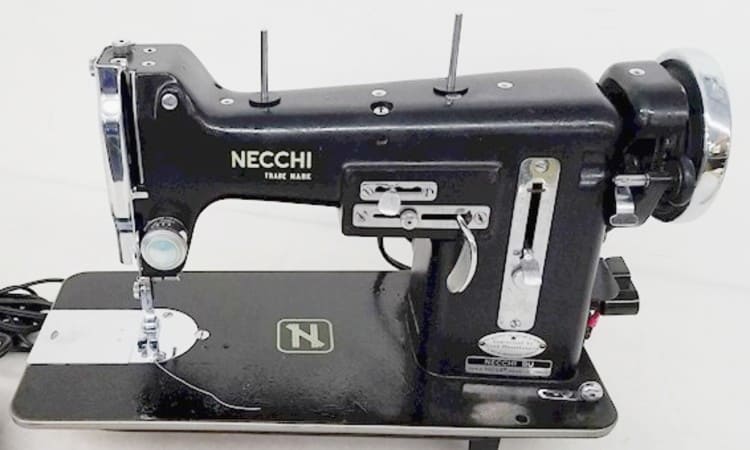
Necchi states that the BU model released in 1932 was the first domestic zigzag machine ever sold. Whether or not all other sewing machine manufacturers would agree with this, it certainly did have a lot to offer!
This flatbed machine uses an oscillating hook and has an adjustable needle position. Everything about it exudes power: it can use upholstery thread and power through pretty much any type of material!
The slight downside to this early model is that it requires a lot of oiling. The BU manuals suggest oiling certain components every time you use the machine! In part, this is a good thing, though, as it is caused by the extremely precise fitting of the pieces inside the machine.
The thing to know about the popular BU model is that Necchi continued to release this model for quite a few years, so some have more advanced features than others. Necchi used the “BU” model name for all of its early zigzag models.
These models usually come in super-heavy cast iron with chrome facings and settings. Most BU models also came built into a nice wooden cabinet or table. Since these models ran on electric motors, the tables will not have a foot treadle as antique sewing machines did.
BF Mira
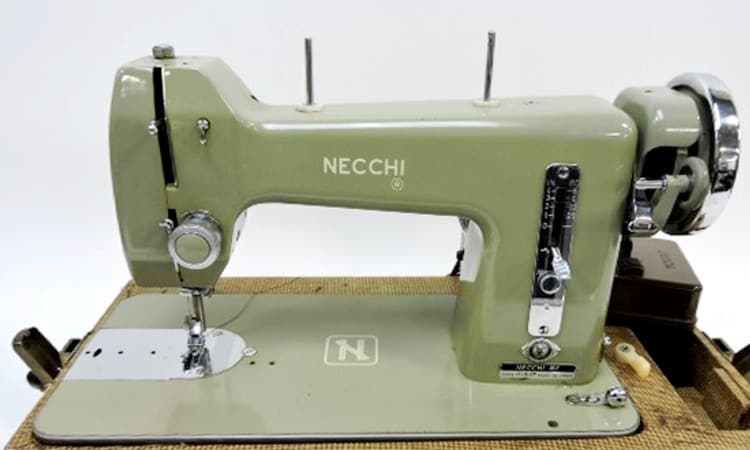
The Necchi BF Mira hit the market in 1950. While not one of the fancy all-star Necchi models, it does offer a heavy-duty, sturdy straight stitch option that runs reliably. Necchi used the designation “BF” to indicate any straight-stitch model.
Since automatic and zigzag models quickly took precedence over these older models, the BF line didn’t have as much popularity as the BU models. That said, it still comes with an impressive motor that you can set to high or low speed.
It also has adjustable feed dogs that allow for different types of sewing, like embroidery. Today, you only get that feature on fancy, expensive sewing machines!
Necchi Supernova
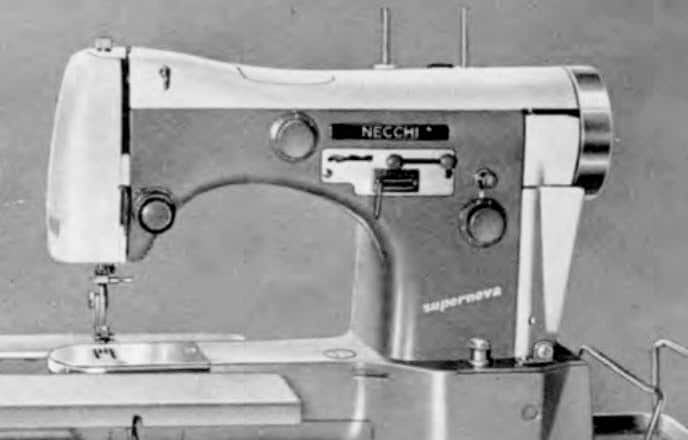
The Necchi Supernova made a big splash in 1954. In Italy, this new model won the Compasso D’Oro award. It also received official sponsorship from the famous actress Sophia Loren.
As you can imagine, this sponsorship helped create great marketing for housewives around the world! After all, if suave, sexy Sophia Loren liked this machine, who wouldn’t?
Besides the excellent marketing, this machine came with many wonderful features. It used insertable drop-in cams to create fancy stitching patterns. It had a sideways twin needle option and a feed dog cover for embroidery stitching.
Necchi models didn’t sport the bright metallic colors of the Japanese-made machines from this era. The Supernova usually comes in a cream or tan color that may yellow with age. Despite that, some models have a sleek, curvy shape that sets them apart from the boxier look of many midcentury sewing machines!
Necchi Mirella
Necchi produced the Mirella models in 1956 to much acclaim. In fact, this gorgeous, uniquely shaped sewing machine is on display at the MOMA today, thanks to its originality! The machine has a swooping, long curve of a shape instead of the traditional boxy square.
This model also won several prizes for its aesthetics and originality, including the Grand Prix award at the Triennale di Milano.
Interestingly, despite its artistic flair and later production date, this machine only does straight stitching and reverse. Its unique body contains lightweight cream or green-colored aluminum instead of the heavy castiron of older models. It uses a rotary hook and has a free arm option.
The machine does come with some setbacks, though. It requires a special type of bobbin designed specifically for it. It also has a somewhat inaccessible motor. Plus, of course, it’s super rare today and can cost quite a lot!
Necchi Esperia in Cabinet
Necchi sold the Esperia line from 1959-1962. These models sometimes come in green or pale pink. They offer a straight stitch option but can sew through leather and thick upholstery fabric!
Generally speaking, any vintage sewing machine that comes in the original cabinet has more value than one without a cabinet. However, you want to investigate to make sure you have found a Necchi cabinet, not a White or Sear cabinet someone stuck the Necchi Esperia into!
Here’s the other mystery about the Esperia models: it seems almost certain that some of the Esperia models were made in Italy. They have a good reputation for their powerful, reliable stitching. That said, some later Esperia models may have been made in Japan and some sewers question the quality of these particular Esperia models.
The other big downside to this model that debuted after the end of Necchi’s glory days is that it’s almost impossible to find any information about these models!
Necchi Models Made in Japan
As you now know, Necchi transitioned its manufacturing to Japan sometime around 1970. If you have a later Necchi model, look for the letters “JA” stamped on it, often with the serial number.
Pretty much any Necchi model made in the 1970s and 80s falls into this category. The 538 models 539 were among those post-Italian models. It seems likely that these models were made in a factory called Zenith Nito.
Not a lot is known today about how much oversight Necchi retained over the Japanese-made models. What you can verify as fact is that most of these models–like all sewing machines at the time–began to use plastic parts instead of steel parts.
It’s the inferior material that makes these models less valuable, not where they were made.
Modern Necchi Models
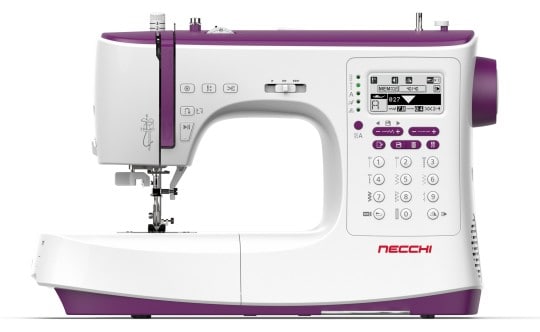
Modern Necchi sewing machines compare well to Janome and Singer models. You can find Necchi sewing machines at affordable beginner prices or higher-end prices comparable to Janome’s embroidery and quilting machine prices.
The marketing materials and company website would like you to believe that these models come from a long line of Italian-made craftsmanship, but don’t be fooled! Janome owns the Necchi brand and has all the manufacturing done in Taiwan and China.
As just a couple of examples, the Necchi EX30 offers 30 stitches, a removable free arm, and a speed control slider. It costs anywhere from $599 to $999, depending on the dealer selling it.
The Necchi EX100 basically doubles all of its feature options. It comes with 100 stitching patterns, including 6 different types of buttonholes. It also has a knee lift and extension table. Professional or designers might get the most use of this more advanced model, though it also sells for around $600.
Are Old Necchi Sewing Machines Good?
Vintage Necchi sewing machines made before 1960 have an excellent reputation. You can find many avid Necchi lovers who will swear that their old Necchi sewing machine is the best sewing machine ever made!
In objective terms, vintage Necchi models often have a pretty high price tag compared to some other old sewing machine brands. They also have solid metal construction and powerful motors. Some of the models come with unique features, as well!
Would a vintage Necchi make the best sewing machine for you? That depends on what you need out of your machine.
If you like the simplicity and reliability of vintage sewing machines, you will probably fall in love with the Necchi models. If you need to sew through leather, upholstery fabric, or denim, you may want a powerful vintage model to get the p done. On the other hand, if you want a fancy computerized machine, you should look at modern machines instead.
Necchi Sewing Machine Value
Some vintage Necchi models have a quite high average price of around $400. In general, most vintage sewing machines have an average price of around $100, so you can see that vintage Necchi’s rank quite highly!
In part, this happens because Necchi models are rarer today. The Necchi factory in Italy didn’t produce as many models as a large-scale operation like Singer. This makes certain vintage models highly collectible today.
Of course, the other key factor is that Necchi had a great reputation back in the day. People continue to value vintage Necchi sewing machines today because of how well they run!
You have probably picked this up by now from reading this article, but you do need to watch out for later Necchi models. While there’s nothing necessarily wrong with the models made in Japan, they do use lower-quality parts instead of solid steel.
Plus, the later models have much lower prices. You can often find them available for $40-$80 at thrift stores or online.
Dating Necchi Sewing Machine
The easiest way to date a Necchi sewing machine is to locate the serial number and contact Necchi here to ask for information. Necchi does make a point of disclaiming responsibility for older models, though, so as a backup plan, you can also find the model number on your machine and match it to the chart in this article!
Finally, one of the best ways to get info on a vintage sewing machine is to join an online discussion group. Other sewers who have the same model often post tips about how to oil the machine or how to insert it into a sewing cabinet. Plus, some nice sewers will even share downloadable sewing machine manuals with you if you ask!
Necchi Sewing Machine Manual
Necchi sewing machine manuals give you vital information about how to set up and operate your vintage machine. You should never try to use a sewing machine without reading the owner’s manual first, but this especially holds true with Necchi models!
Some of these vintage models come with unique parts. Others require specific care that you might not know about, like oiling some parts every time you sew!
But what if your vintage machine no longer has its trusty manual? Here’s the bad news: you probably can’t get a replacement manual from Necchi today. The company offers excellent support for its current models, but if they no longer sell it, don’t expect help!
On the other hand, your fellow sewing enthusiasts will often willingly share a manual. Check out sewing blogs, discussion forums, and chat boards to see if anyone has already shared a digital copy!
Of course, you can also buy a replacement manual. eBay and Etsy usually offer a good selection of sewing machine manuals at a low cost.
Necchi Sewing Machine Parts
Most vintage Necchi models use a class 15 bobbin and other easily accessible sewing machine parts that you can buy on eBay or Etsy. You can sometimes even find attachments that will work with your Necchi made by another brand like Singer or Griest.
That said, some models like the Mirella require a model-specific bobbin and other parts. This means that you may have a hard time finding certain replacement parts for your vintage Necchi machine.
In general, make sure you always search for parts for your specific model. Just plugging in “Necchi sewing machine parts” is too generic and will not give you the kind of parts meant specifically for your Necchi model!
How To Thread a Necchi Sewing Machine
Some Necchi models have slight variations in the thread path, but threading most vintage models looks a lot like threading a modern sewing machine today! Some models may place the spool pin on top of the arm near the needle bar rather than on the back or near the handwheel like a modern machine, though.
That said, make sure you read the instructions in your manual before you try to thread your vintage Necchi for the first time. You should also clean the machine before threading to avoid jamming built-up lint into the thread path or bobbin casing.
- First, raise the needle all the way by turning the handwheel.
- Insert your spool of thread onto the spool pin. Pull free about six inches of thread.
- Find the closest thread guide (usually a chrome knob or hook near the spool pin) and run the thread over it.
- Next, drop the thread down to wrap beneath the tension dial and back up, pausing to catch under the hook to the left of the knob.
- Take the thread back up to the raised thread take-up lever. On some older models, you have to poke the thread through a tiny hole in the lever rather than wrapping it over the hook as you do in newer models.
- Finally, follow the remaining two hooked thread guides down to the needle, and thread the needle front to back!
Conclusion
Vittorio Necchi founded his sewing machine manufacturing company in 1924 and ran it successfully for many decades. Necchi sewing machines offered innovations like the first domestic zigzag machine. They had a great reputation for superior craftsmanship and quality parts.
In the 1950s, several Necchi models won awards and received global recognition. The 1960s saw a decline in the company’s reputation due to competition from Japan. Today, vintage Necchi models made before 1960 still demand a high price due to their excellent quality!
Do you own a vintage Necchi model? What do you like best about sewing on this machine? Leave a comment below to let us know!
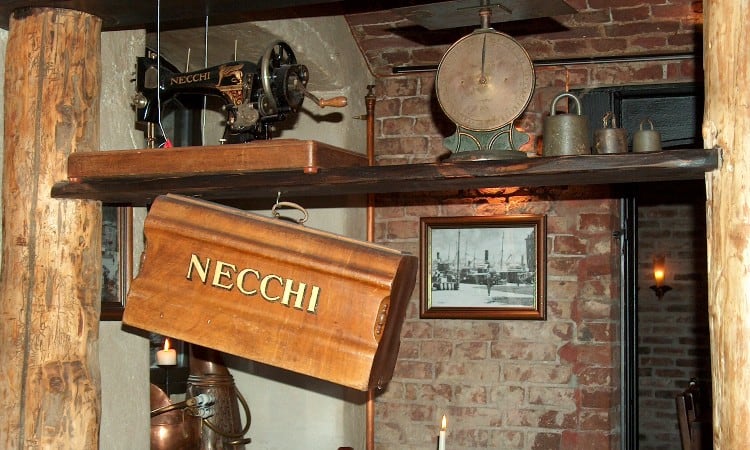
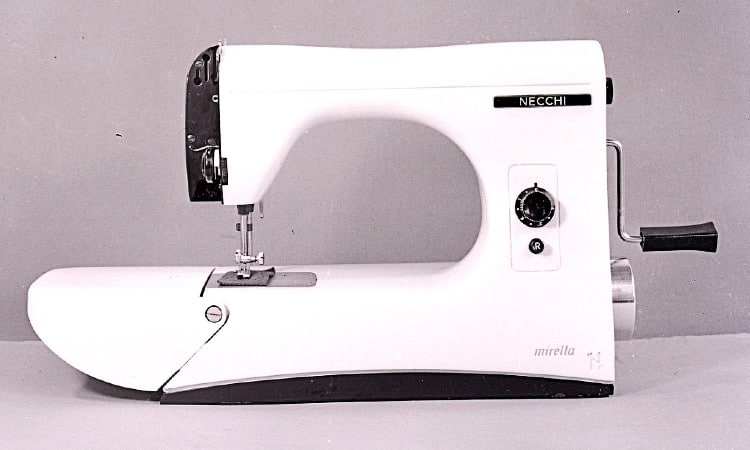
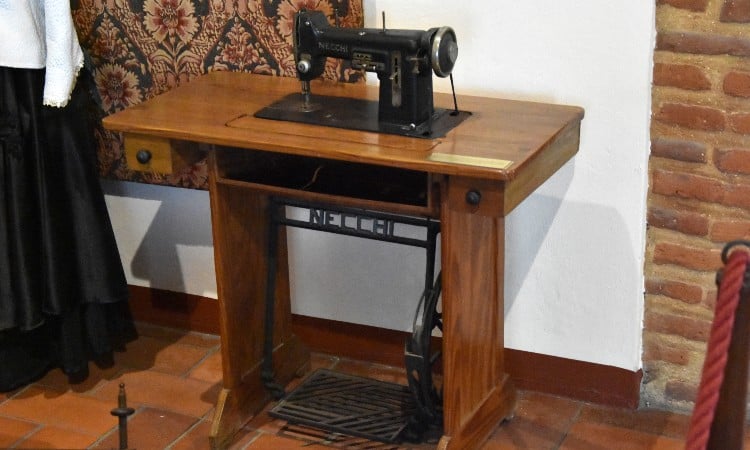
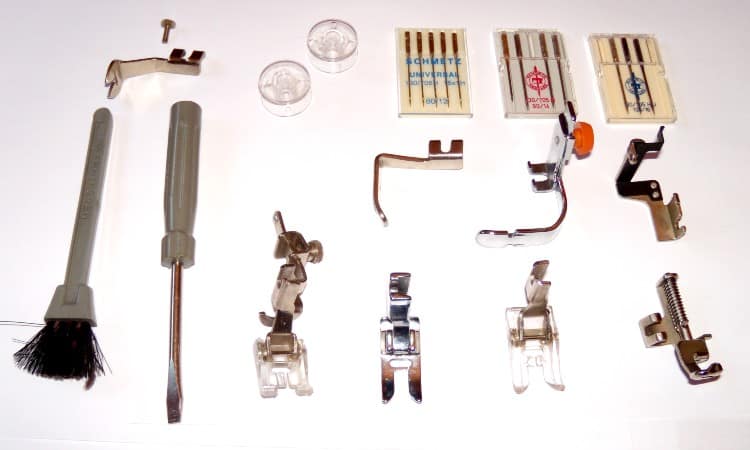
Linda mitten
Sunday 7th of November 2021
I learned to sew on my mother’s black Necchi from the early 1950’s. I entered college as a Home Economics major in 1971 and that Necchi came to college with me where I took several clothing construction classes. That machine was a work horse! When I started teaching in 1974 I experienced the frustration of classroom Singer models with the wind in bobbin! Ugh! I was eventually able to replace those with Berninas also from Italy. I have an old Bernina from 1980 and did inherit my mom’s Necchi. I have not used it in ages. When I last plugged it in to use the plug began to smoke in the outlet. I would like to get that replace and give it a good tune up. I am sure it will still stitch like a dream!